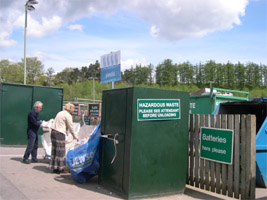 |
 |
 |
 |
 |
 |
 |
 |
 |
 |
 |
Important issues
The main issues associated with waste management within urban infrastructure include avoiding waste through design and operation stages, reuse or recycling of waste, efficient collection and separation of waste at source and economic and social aspects including the role of the public and public perception.
A number of waste related issues have been highlighted through the development
of the PETUS project. The issues identified include:
• Better management for disposal of waste,
• Minimisation of construction waste through the consideration of materials
used,
• Waste transportation: reduction of waste to prevent increased waste
transportation.
1) Better management for disposal of waste
The waste hierarchy identifies the different levels of waste management available:
• REDUCE - the most effective environmental solution is to reduce the
generation of waste.
• REUSE - where further reduction is not practicable, products and materials
can sometimes be used again, either for the same or a different purpose.
• RECYCLE - Value can be recovered from waste through recycling or composting,
or through energy recovery (see PETUS case study: Waste management concept –
Plastics).
• DISPOSAL - Only if none of the above offer an appropriate solution should
waste be incinerated without energy recovery, or disposed of to landfill. This
should be managed very carefully to minimise the impact on the surrounding environment
in a socially and economically acceptable way (see PETUS case studies: Assessment
of organic waste treatment, Denmark and Solid waste in Copenhagen).
The problems with waste disposal are:
• Landfill and incineration can create a number of problems in terms of
pollution – air, water and soil and can impact on human health;
• In addition, landfill capacity is decreasing;
• The need to reduce waste disposal in accordance with the EU aims, of
20% from 2000 levels by 2010, and by 50% by 2050.
For more information: Better management for disposal of waste
2) Minimisation of construction waste through the consideration of materials
used
In order to reduce the amount of construction waste it is essential that consideration
is given to the materials used in a development to ensure that material could
be reused at a later date or that the material is biodegradable or has the same
lifespan as the building. During the PETUS research no case studies were found
that used tools to specifically consider the materials used in order to minimise
waste.
Only a few countries have obtained recycling rates for construction and demolition waste of 80%.
With interaction between producers and consumers, producers could consider reduction options from product design through manufacturing to transportation packaging and point of sale with the consumer making an active decision to purchase goods that produce minimum waste.
For more information: Minimisation of construction waste through the consideration of materials used
3) Waste transportation: reduction of waste to prevent increased waste transportation.
Waste that is to be recycled, reused or disposed of needs to be transported
from location of generation to location of next use or disposal.
Increased use of brownfield sites has increased the requirements for transportation of hazardous waste, which is an increased problem since there are fewer hazardous waste disposal sites. The Directive on Landfill Waste (1999) specifies that collection and composting of biodegradable waste will be required at the point of generation for transportation for reuse or composting to be substantially reduced.

Issues associated with transportation of waste include:
• Increased numbers of vehicles creating pollution on EU roads,
• Noise and air pollution,
• Increased congestion on roads.
For more information: Waste transportation: reduction of waste to prevent increased waste transportation.